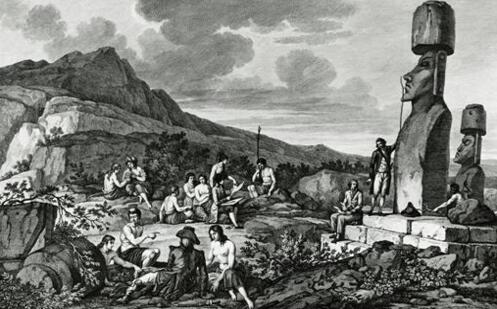揭开复活岛的神秘!DNA或许是解开其神秘面纱的金钥匙
2017-10-17 11:21
来源:NewYork Times
作者:
A small green dot lost in the vastness of the southeastern Pacific Ocean, Easter Island has long enchanted archaeologists and the public. Hundreds of giant stone figures, or Moai, that decorate the volcanic island remain a source of fascination.
复活节岛是迷失在东南太平洋广阔海面上的一个小小绿点,长期以来,一直令考古学家们和大众为之着迷。成百上千的石像,或者巨石像装饰着火山岛,成为迷人的源泉。

One of the greatest mysteries about Easter Island, also known as Rapa Nui, concerns the identity of its earliest inhabitants, the architects of the stoic statues. Did they have genetic ties to natives on the South American land mass thousands of miles away, or were their origins solely in the Pacific islands to the west?
复活节岛(又称复活岛),最大的神秘之一是岛上最早居民的身份无法确定,也就是那些石雕的雕刻者。他们与相隔甚远,数千英里外的南美大陆有基因联系吗,或者说他们唯一的来源就是往西去的太平洋岛屿吗?
A study published Thursday in the journal Current Biology found only evidence of Polynesian DNA in human remains on the island that predate European contact in 1722. Though the sample size was small, the findings may change what we know about the early explorers who found the remote island and constructed perhaps some of the most iconic statues in the world.
星期四时,刊登在《当代生物学》杂志上的一项研究,只发现了依然在岛上的波利尼西亚人的人类DNA,而这样的DNA要早于1722年欧洲人接触此岛时的DNA。尽管样品规模很小,但这样的发现可能会颠覆我们对早期探险者的认知,会认为他们发现了遥远的岛屿并可能建造了世界上最具标志性雕像中的某些。
“They are 100 percent completely Polynesian ancestry as far as we can see,” said Pontus Skoglund, a geneticist at the Francis Crick Institute in London and an author of the paper. “We find that these people came from the west and it tells us about this extraordinary journey they took to get there through the waves of the Pacific.”
伦敦弗朗西斯.克里克研究所的遗传学家和报纸编辑者,蓬图斯.史克格伦德 说:“就目前来看,他们完全百分之百地是波利尼亚人的血统。”,“我们发现这些人来自西边,它向我们诉说了他们乘风破浪越过太平洋到达这里的不可思议的旅程。”。
Looking at a map, one would be challenged to find a more impressive place than Easter Island where people ventured without the benefit of modern navigation. Just three times the size of Manhattan, it is more than a thousand miles from its nearest island neighbor to the west and 2,200 miles from Chile to the east, yet people have lived there for more than 800 years.
查看地图,会心存狐疑地发现复活岛这个引人注目的地方。更令人惊奇的是,冒险来到这儿的人在当时是没有现代导航这样的工具做协助的。要知道,这个岛是曼哈顿市的三倍之大,距离最近邻岛的西岸就超过1000英里,智利东海岸达2200英里,然而人们定居此地已经多达800年了。
Scientists have long wondered how early people sailed to the island — as well as how they built the island’s impressive Moai.
科学家们一直想知道早期的人们是如何航行到这个岛上的,并且他们是如何建造这个岛上令人印象深刻的石像的。
Genetic tests have shown that the modern Rapanui people have a mix of Polynesian, South American and European ancestry. Some scientists have used the modern DNA results to suggest that Polynesians from the west and native South Americans from the east lived and intermingled on the island before Europeans first arrived in 1722. And in the famous Kon-Tiki expedition, a Norwegian explorer named Thor Heyerdahl showed on a balsa wood raft how South Americans could have voyaged to the Polynesian islands during pre-Columbian times.
基因测试显示,现在的拉帕努伊岛人具有波利尼西亚人、南美人以及欧洲人祖先的混合血统。一些科学家利用现代DNA测试结果来表明,来自西边的波利尼西亚人和来自东边的南美土著人定居并混居在此岛的时间要早于在1722年首次抵达此岛的欧洲人。在著名的康蒂基号探险活动中,一名挪威探险家,托尔?海尔达尔利用一个巴沙木轻木筏向人们展示了在哥伦比亚被发现前期,南美人是如何航行到波利尼西亚岛上的。
But that does not mean it was probable, according to Lars Fehren-Schmitz, a biological anthropologist from the University of California, Santa Cruz, and lead author of the study.Using rib bones from five Easter Island individuals from 1445 to 1945 that had been excavated in the 1980s and stored in the Kon-Tiki museum in Norway, Dr. Fehren-Schmitz and his colleagues attempted to sequence the genome of the island’s earliest inhabitants. The team extracted enough useful genetic information from the remains to analyze and draw conclusions that could be representative of the larger ancient population.
然而,根据加州大学圣克鲁斯分校生物人类学家Lars Fehren-Schmitz作为该研究的主要参与者认为,上述观点并不意味着可能就是那样。在挪威康蒂基博物馆保存有生活在1445年到1945 年的复活岛人的肋骨,这些肋骨于1980年发掘,利用五具人的肋骨,Fehren-Schmitz博士和他的同事尝试着将岛上最早居民的基因组按次序进行了基因组排列。他们从这些遗体中提取了足够可用的遗传信息来进行了分析,并得出可以代表较大人数规模的结论。
“I was pretty surprised when we didn’t find any Native American signals in our pre-contact samples,” Dr. Fehren-Schmitz said. “Honestly, at first I thought I did something wrong with the statistics. Then it was an ‘a-ha moment.’”
Fehren-Schmitz博士说:“很惊讶的是,我们在前面接触的样品中没有发现任何美洲土著人的信息。”,“坦白的讲,起先我认为是自己数据统计出了毛病,后来发现那是一个‘轻松一刻’罢了。”。
Scientists who were not involved in the study pointed out some of its limitations.
然而,没有参与到此项研究当中的科学家们指出了其中存在的一些局限性。
“This is a valuable work as it presents the first ancient whole genome data from Rapa Nui,” Víctor Moreno-Mayar, a geneticist at the Natural History Museum of Denmark, said in an email. But he cautioned that with only a handful of samples, the team did not have enough data to generalize about the genetics of the entire ancient population.
丹麦自然历史博物馆遗传学家Víctor Moreno-Mayar,在一封邮件中这样写道:“这项工作展示的一手Rapa Nui古老的全部基因组数据资料是很有价值的”。但是他提醒道,他们只有少量的样品,没有足够的数据资料来归纳所有的古时人口的基因。
He was lead author on a paper in 2014 about the genetical testing of a sample of 27 modern Rapanui that found they inherited about 8 percent of their DNA from Native Americans. The paper also suggested that natives of South America may have come or were brought to Easter Island around 1340 A.D.
关于27个现代Rapanui人的基因测定样品,他作为2014年论文的主要撰稿人,发现他们继承了美洲土著人的DNA。这篇论文还表明南美洲土著人可能已经来了或者在公元1340年被带到了复活岛。
Dr. Erik Thorsby, an immunologist at the University of Oslo in Norway and his co-author, agreed.
挪威奥斯陆大学免疫学家Erik Thorsby博士及其合著者同意此观点。
“A few Native Americans may have reached Rapa Nui early, and their ancestral genes may be easily missed when ancient DNA from only five individuals are investigated,” he said.
他说:“一些美洲土著人可能早期已经到达了Rapa Nui,如果只从五个人的DNA中做研究调查的话,他们祖先的基因或许很容易就丢失了。”。
Dr. Fehren-Schmitz acknowledged that the sample size was limited, but he said his investigation has shown that the history of the populations on Rapa Nui is more complicated than previously thought.
Fehren-Schmitz博士承认样本量有限,但是他说他的调查已经显示Rapa Nui人口的历史比之前预想的要更加复杂。
“What we can say is, at the time where those individuals lived that we tested, Native American ancestry was not distributed through the population of Rapa Nui,” he said. “Either that exchange didn’t happen or it only happened with specific parts of the population on the island. Both things would be very interesting.”
他说:“这样说吧,我们测试的那些彼时彼地的人,通过Rapa Nui的人口显示,美洲土著人的祖先没有分流。”,“没有一方发生过交流或者说只发生在岛上人口的某些具体部分。而这些事情将会非常有趣。”
His colleague, Cat Jarman, a doctoral student and archaeologist from the University of Bristol in England and a co-author on the study, said that European enslavement of the islanders may account for Native American ancestry in the modern DNA of the Rapanui.
他的同校同事Cat Jarman ,是来自于英国里斯托大学的博士生和考古学家,也是研究的合著者。他说欧洲奴役的这个岛上的岛民,在现代Rapanui人的DNA中,可能会解释美洲土著人祖先的信息。
In the 1860s, Europeans took as much as half of the population of Easter Island to Peru as slaves. After a public outcry, the slavers were forced to return some of these people to Easter Island, though they came back with diseases and at one point the population fell to as few as 111 people, according to Mrs. Jarman.
19世纪六十年代,欧洲人将多达复活岛一半的人口当做奴隶贩卖至秘鲁。据贾马尔女士说,经过公众强烈的抗议后,尽管这些奴隶中的一部分人带有疾病,岛上人口也少到了111人,但还是被强制送回复活岛。
“When we look at this modern DNA, it’s not necessarily representative of the population that was there 800 years ago because so much has happened,” Mrs. Jarman said. “So many people have moved because of slavery and it’s had a huge genetic impact that we need to take into account when we look at the modern population.”
贾马尔女士说:“当看到这些现代人的DNA统计数据时,我们说, 800年前发生过那么多事,它当然不会代表所有的人口了。”,“由于贩卖奴隶,那么多人都有变动,这种变动对基因造成了巨大的影响。所以当我们在看这些现代人的DNA时,需要把这些影响因素考虑进去。”
Anna-Sapfo Malaspinas, a population geneticist at the University of Lausanne in Switzerland and was an author on the 2014 paper with Dr. Thorsby and Dr. Moreno-Mayar, said the latest study suggested possibilities for future research.
Anna-Sapfo Malaspinas是瑞士洛桑大学的一名人口遗传学家,和Thorsby博士 以及 Moreno-Mayar博士都是2014年论文的作者。他说,最近的研究对未来探索的成功提高了可能性。
“At the time we published our paper, we felt that the way to go forward was to indeed analyze ancient DNA to give more insight into the timing of the mixture,” Dr. Malaspinas said. “It’s a mystery we need to work more on. There’s a lot still to uncover.”
Malaspinas博士说:“当时,我们发表了我们的论文,我们认为这种通过分析古时DNA的方法,实际上是前进了一部,对复杂的时代给予了更广阔的视角。”,“这是一个谜,我们要做的工作远不止这些,还有很多东西仍然有待发现。”。







